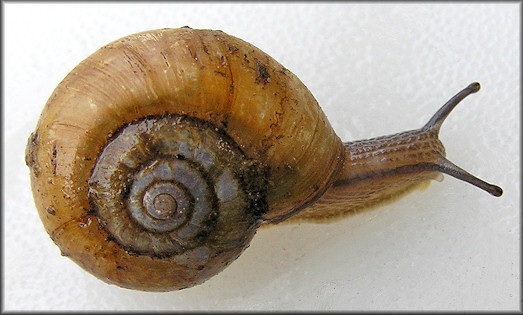Adaptation
Haplotrema concavum are a carnivorous
species of snail, so many of its adaptations are for finding and
eating other animals, instead of plants. One such adaptations is
that the jaw is reduced to a narrow, erescentic plate with a
medium point on the cutting edge (Baker, 1930). This
narrowing of the jaw allows for it to stick its jaw into another
snail's opening to try and get it out.
The radula also has a few, inverted chevron-shaped, transverse rows
of teeth, which are used to scrap against an egg or another
snail's shell. (Baker, 1930). The remainder of the teeth
on the inside increase in size, while the outer teeth decrease in size (Baker, 1930). This
anatomical data shows that Haplotrema is a diverging group, or quite different then snails of a
similar species(Baker, 1930). Its jaw and the central part
of its radula are remnants of an ancestral species of snail with
its aculeate outer teeth similar to those of the family of snail, Streptaxidae (Baker, 1930).
That shows that the Haplotrematidae and Streptaxidae share a
similar ancestor and evolved separately from this ancestor.
The entocones, which are similar to molars in mammals, on the inner teeth are a special feature of this
species and differs from the raised entocones that are the
trademark type of teeth that are known to the pulmonates
(Baker, 1930). Most species of snail have an albumen
gland, which secretes a liquid over the snails' eggs, that is a
single organ, but in the Haplotrema concavum this organ
is
split into a double organ (Baker, 1930). Perhaps
this allows the snail to cover the egg faster and more
efficiently. Also, in the
various species in the group Haplotrema, the genitalia show
considerable diversity (Baker, 1930). This means that different
species have evolved, so that they can reproduce differently and
keep their species separate from other species. In all of the
snails in the genus Haplotrema there is one common
characteristic, and that is the penis is created from the epiphalloid chamber rather
than the vas deferens (Baker, 1930). These many
adaptations allow this species of snail to have a better chance
of survival and reproduction.
those of the family of snail, Streptaxidae (Baker, 1930).
That shows that the Haplotrematidae and Streptaxidae share a
similar ancestor and evolved separately from this ancestor.
The entocones, which are similar to molars in mammals, on the inner teeth are a special feature of this
species and differs from the raised entocones that are the
trademark type of teeth that are known to the pulmonates
(Baker, 1930). Most species of snail have an albumen
gland, which secretes a liquid over the snails' eggs, that is a
single organ, but in the Haplotrema concavum this organ
is
split into a double organ (Baker, 1930). Perhaps
this allows the snail to cover the egg faster and more
efficiently. Also, in the
various species in the group Haplotrema, the genitalia show
considerable diversity (Baker, 1930). This means that different
species have evolved, so that they can reproduce differently and
keep their species separate from other species. In all of the
snails in the genus Haplotrema there is one common
characteristic, and that is the penis is created from the epiphalloid chamber rather
than the vas deferens (Baker, 1930). These many
adaptations allow this species of snail to have a better chance
of survival and reproduction.